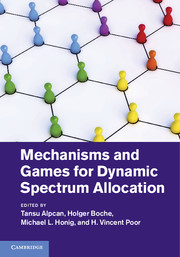Refine search
Actions for selected content:
48240 results in Computer Science
10 - Capacity scaling limits of cognitive multiple access networks
- from Part II - Cognitive radio and sharing of unlicensed spectrum
-
-
- Book:
- Mechanisms and Games for Dynamic Spectrum Allocation
- Published online:
- 18 December 2013
- Print publication:
- 19 December 2013, pp 304-332
-
- Chapter
- Export citation
Mechanisms and Games for Dynamic Spectrum Allocation - Title page
-
-
- Book:
- Mechanisms and Games for Dynamic Spectrum Allocation
- Published online:
- 18 December 2013
- Print publication:
- 19 December 2013, pp iii-iii
-
- Chapter
- Export citation
1 - Games and mechanisms for networked systems: incentives and algorithms
- from Part I - Theoretical Fundamentals
-
-
- Book:
- Mechanisms and Games for Dynamic Spectrum Allocation
- Published online:
- 18 December 2013
- Print publication:
- 19 December 2013, pp 3-31
-
- Chapter
- Export citation
19 - Economics and the efficient allocation of spectrum licenses
- from Part III - Management and allocation of Licensed spectrum
-
-
- Book:
- Mechanisms and Games for Dynamic Spectrum Allocation
- Published online:
- 18 December 2013
- Print publication:
- 19 December 2013, pp 552-578
-
- Chapter
- Export citation
Copyright page
-
- Book:
- Mechanisms and Games for Dynamic Spectrum Allocation
- Published online:
- 18 December 2013
- Print publication:
- 19 December 2013, pp iv-iv
-
- Chapter
- Export citation
11 - Dynamic resource allocation in cognitive radio relay networks using sequential auctions
- from Part II - Cognitive radio and sharing of unlicensed spectrum
-
-
- Book:
- Mechanisms and Games for Dynamic Spectrum Allocation
- Published online:
- 18 December 2013
- Print publication:
- 19 December 2013, pp 333-351
-
- Chapter
- Export citation
2 - Competition in wireless systems via Bayesian interference games
- from Part I - Theoretical Fundamentals
-
-
- Book:
- Mechanisms and Games for Dynamic Spectrum Allocation
- Published online:
- 18 December 2013
- Print publication:
- 19 December 2013, pp 32-56
-
- Chapter
- Export citation
17 - Economic models for secondary spectrum lease: a spatio-temporal perspective
- from Part III - Management and allocation of Licensed spectrum
-
-
- Book:
- Mechanisms and Games for Dynamic Spectrum Allocation
- Published online:
- 18 December 2013
- Print publication:
- 19 December 2013, pp 495-517
-
- Chapter
- Export citation
14 - Economic viability of dynamic spectrum management
- from Part III - Management and allocation of Licensed spectrum
-
-
- Book:
- Mechanisms and Games for Dynamic Spectrum Allocation
- Published online:
- 18 December 2013
- Print publication:
- 19 December 2013, pp 396-432
-
- Chapter
- Export citation
5 - Power allocation and spectrum sharing in wireless networks: an implementation theory approach
- from Part I - Theoretical Fundamentals
-
-
- Book:
- Mechanisms and Games for Dynamic Spectrum Allocation
- Published online:
- 18 December 2013
- Print publication:
- 19 December 2013, pp 108-144
-
- Chapter
- Export citation
Part I - Theoretical Fundamentals
-
- Book:
- Mechanisms and Games for Dynamic Spectrum Allocation
- Published online:
- 18 December 2013
- Print publication:
- 19 December 2013, pp 1-226
-
- Chapter
- Export citation
8 - Cooperation in cognitive radio networks: from access to monitoring
- from Part II - Cognitive radio and sharing of unlicensed spectrum
-
-
- Book:
- Mechanisms and Games for Dynamic Spectrum Allocation
- Published online:
- 18 December 2013
- Print publication:
- 19 December 2013, pp 229-261
-
- Chapter
- Export citation
13 - Self-organizing context-aware small cell networks: challenges and future opportunities
- from Part III - Management and allocation of Licensed spectrum
-
-
- Book:
- Mechanisms and Games for Dynamic Spectrum Allocation
- Published online:
- 18 December 2013
- Print publication:
- 19 December 2013, pp 373-395
-
- Chapter
- Export citation

Mechanisms and Games for Dynamic Spectrum Allocation
-
- Published online:
- 18 December 2013
- Print publication:
- 19 December 2013
Social networks, time homeless, and social support: A study of men on Skid Row
-
- Journal:
- Network Science / Volume 1 / Issue 3 / December 2013
- Published online by Cambridge University Press:
- 18 December 2013, pp. 305-320
-
- Article
- Export citation
Generating explanations for biomedical queries
-
- Journal:
- Theory and Practice of Logic Programming / Volume 15 / Issue 1 / January 2015
- Published online by Cambridge University Press:
- 17 December 2013, pp. 35-78
-
- Article
- Export citation
